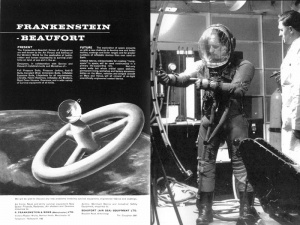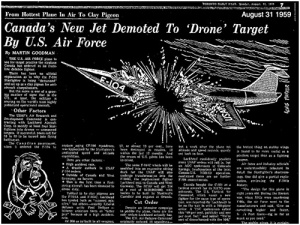The Empire Strikes Out - Canada's Defence & The Commonwealth Space Program - Part 5 by Robert Godwin
From The Space Library
While the future of Canada’s aerospace industry was being completely rewritten the pre-arranged Commonwealth Space Symposium finally took place in London on August 27th. Phil Lapp and Arthur Maine hurriedly put together a paper which was right up to date, including the news about the Canadair contract. The pair apologized for what they perceived was a hurried summary of Canada’s aerospace capabilities. They were not able to attend the conference in person, but despite their trepidation their paper, entitled Canadian Facilities, was a brilliant overview and included a mass of statistics from every possible part of the Canadian economy that might be impacted by a space program. They noted that the aircraft industry comprised 39,000 employees and 7.7M square feet of floor space. This was after the 12,500 layoffs at Avro and the loss of 1.7M square feet now under-utilised at that moment. When discussing the electronics industry Lapp noted, “most contributions to the electronic arts arising in Canada have some link with the geography or conditions peculiar to the country.”
He then clearly described Canada’s space future, "In terms of astronautical applications, the industry is well suited to contribute in practically any electronic area with perhaps special ability in communications, tracking, and data handling and processing." He also paid special attention to Canada’s chemical industry which made it perfectly suited to supply propellants derived from its rich resource-base and concocted by its chemical engineers.
At this time many in the astronautics field were actively advocating nuclear propulsion as the best method to open up space travel. Lapp and Maine pointed out that Canada was already a world-leader in advanced nuclear reactors.
Lapp’s friend Gerald Bull was also leading the world when it came to building guns capable of accelerating payloads to speeds comparable to a re-entering ICBM. The paper went on to point out that The Defence Research Medical Laboratories, located in Downsview Ontario, were conducting medical experiments involving motion sickness, decompression and cold, and acceleration in a centrifuge. Similar work was underway at A.V. Roe in England, whose Frankenstein subsidiary was leading the development of British space suits.
British Pressure suit and advertisement for Frankenstein Beaufort, later part of A.V. Roe (Circa 1962)
Canadian universities had over 6000 students enrolled from Commonwealth countries as well as over 400 Canadians attending British institutions. Lapp and Maine also concluded that Canada was uniquely located for a high latitude launch complex for a variety of reasons including the low intensity of the Van Allen radiation belts. This observation drew attention from the delegates because of its eminent practicality, but it stood little chance of being seriously considered because the Woomera launch facility was well under way and the Australian High Commissioner, Sir Eric Harrison, had been there personally to open the conference and to make sure that Australia's interests were front and centre.
Finally, neither Lapp nor Maine had any delusions about Canada being able to go-it-alone.
"Since the British Commonwealth already exists as a freely co-operating group of countries with common interests and traditions, one might suppose that a reasonable measure of success should attend a Commonwealth space program venture. If it could be shown that this would not be the case then the outlook is indeed bleak for the completely international co-operation in space research so keenly sought by IAF and the COSPAR agency of the United Nations. It seems to be imperative that the nations of the world come to a common agreement on the conquest of space, and surely the Commonwealth has a part to play in bringing this about."
The report is so well handled it seems that Phil Lapp had found a new role. Not only did he go on to co-author the so-called Chapman Report in 1967 but he would spend the rest of his life consulting and writing hundreds of complex reports for every branch of the aerospace and resources industries in Canada. If you wanted to know what Canada could do, you asked Phil Lapp.
The British Interplanetary Society had done a superb job of bringing together the various interested parties. Representatives from fourteen foreign nations attended, including two from the Soviet embassy, one from the US Strategic Air Command and four from Israel's ministry of defence. On the second day De Havilland's Geoffrey Pardoe delivered a detailed explanation of the capabilities of Blue Streak leading many delegates to believe that a Commonwealth program was inevitable since the Blue Streak, outfitted with a Black Knight second stage, could outlift most of the US boosters, with the notable exception of Atlas-Agena-Centaur. Leslie R. Shepherd concluded the proceedings by saying that the BIS intended to host another summit in the future.
Two weeks after Canada geared up its aerospace industry to produce the F-104G the USAF announced that they would forthwith be automating their own F-104s to be used as drones for target practice.48 No aircraft had ever been relegated to such a fate before.
Announcement that Lockheed F-104G converted to drone for target practice (August 1959)
Meanwhile, the Hawker 1127, which could have been built at Avro is still the world's only successful vertical take-off fighter, and would instead be built under license in the USA. After being continuously upgraded it is expected to remain in active service with the US Marine Corps until 2025, making it the most successful fighter in history. The design has not become obsolete, after almost 60 years, even though it is not a supersonic aircraft. It couldn't have effectively defended Canada but it would have made up for that shortcoming with the balance of trade it would have generated. But with the decision to build the F-104G, what little hope that may have remained at Avro was now dashed.
Canada still had to deal with the "new" paradigm, defending against Soviet bombers, which, despite a stream of predictions to the contrary, hadn't all disappeared. By late December discussions were underway to purchase McDonnell's Voodoo aircraft from the United States to reequip the domestic squadrons. USAF General Kuter during a visit to Ottawa said "There will always be need for a manned fighter," somewhat belatedly agreeing with Canada's Chief of Air Staff.49
The Voodoo was apparently capable of intercepting Soviet bombers since it could carry nuclear missiles and had a speed of 1200mph and a range of 2000 miles. None of its specifications matched those of the Arrow which had more range, was faster and could carry more armaments.50 However, the Voodoo was cheaper.
One of the most often quoted critical comments leveled at the Arrow came from a noted expert who said that it "wasn't anything special." While some advocates of the aircraft claim it was better than anything else flying, even today. Both are imprecise statements. The Arrow was special in the sense that it was built to handle "all weather" over a very large patrol area, with a large inboard weapon system which meant it could achieve and maintain extremely high speed. No other fighter was able to do this until the deployment of the F-22 Raptor in 1996.
The size of the weapon's pod meant that it could have handled air-launched nuclear weapons giving it the same stand-off capability as the large supersonic bombers which were available at that time. The critics rarely ever question the unparalleled power of the Iroquois engine which spoke for itself when it nearly ripped the housings out of the test-stand in Malton, Ontario. Even the Velvet Glove missiles the Arrow would have carried would have used propellant designed by Dickinson and others at CARDE, specifically created with the Canadian Arctic in mind and able to withstand the extreme temperature shifts without cracking (a very bad thing to happen in a solid fuel rocket.)
The Arrow was better than anything else, for Canada, at that time. Nine squadrons could have patrolled all 3.5 million square miles. The aircraft excelled in many other critical ways but to say it was superior in every way to modern aircraft is clearly not true. It would be extremely vulnerable to modern radar since the notion of "stealth" technology didn't even exist in 1959.
Randall Whitcomb, a pilot who flew in the Canadian Air Force in multiple fighters including the CF-18 Hornet, conducted an unprecedented analysis of the Arrow. His conclusion in 2008 was,
"The high performance, even when heavily loaded, combined with the capability of the kinds of weapons it could carry, gave the Arrow more potential flexibility than most aircraft built to this day."51
In July of 1961 a batch of 66 Voodoos were delivered to the Canadian Air Force to defend the home territory; a job that the Air Force had told the government would require well over a hundred aircraft.52
The Empire Strikes Out - Canada's Defence & The Commonwealth Space Program - Part 6 by Robert Godwin
Footnotes
48Toronto Star Aug 31 1959
49Globe and Mail Dec 30 1959
50Cold War Tech War Apogee Books; Randall Whitcomb 2008
51Ibid
52Globe and Mail Jul 25 1961


